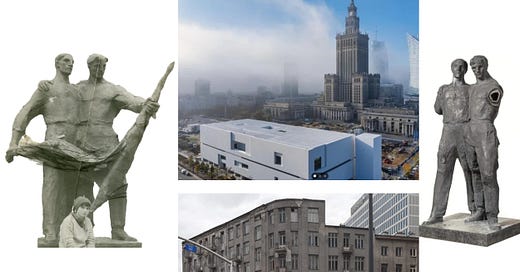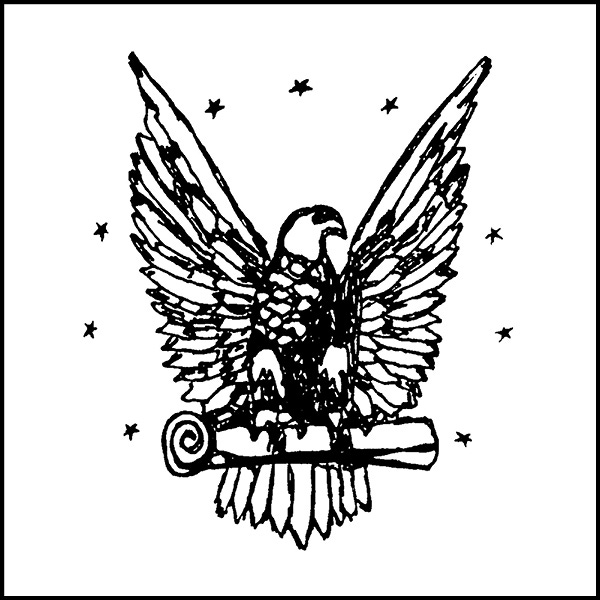Three buildings and two statues in the center of Warsaw, Poland’s capital, frame the history of the country’s tumultuous last one hundred years.
The Palace of Culture and Science, completed in 1955, is a Soviet-era symbol of “friendship” that still dominates the city skyline, although it is now surrounded by gleaming high-rises reflecting Poland’s robust modern economy. In past times, Poles would point at it, shrug, and comment: “Yes, it is small, but at least it is delicate,” which of course it is neither. There have been regular calls for it to be demolished, but the grandiose interior halls are still very much in use, being spacious and — to contemporary Warsaw residents — somewhat kitsch.
On the other side of a large plaza, long used for political flag waving (and about to be a veranda for strolling and tête-à-têtes) is the new Museum of Modern Art, designed by the American architect Thomas Phifer. It is known colloquially as the “Cube,” given its rectangular dimensions. Its collection features twentieth- and twenty-first-century art, primarily by Polish artists, and exhibitions.
The crowd on hand for events recently were notably recognizable in style and animated buzz as members of the global intelligentsia.
Nearby, at Ulitsa Twarda 28, in the shadow of all the surrounding skyscrapers, is an apartment block known as the “Tenement House of Leib Osnos.” Leib (Lionel) was my grandfather, who died in the mid-1930s. This is where his family lived and where my parents huddled after the Nazi invasion of September 1939. With remarkable (in my retrospective discovery of what happened) daring, courage, and luck, my father first and then my mother and eight-year-old brother made it out of Poland and eventually to India, where I was born in 1943, just before they crossed the Pacific to the United States.
I was astonished to learn recently that the building, which was inside the notorious Warsaw ghetto from 1940 to 1942, was the only building on that street not to have been destroyed in the war. In 2019, the building was designated a National Monument. It is shuttered and shabby, yet it is widely known as an artifact of the Holocaust era in the center of Warsaw, one of the very few that is intact.
As explained by my cousin Piotr Hoffman, a Warsaw lawyer, the future of the building is unclear. It apparently cannot be torn down, and renovating it would be costly. Peering through the locked and rusty gates where my immediate family lived in what must have been a terrifying time was eerie.
As for the statues, they are the work of Alina Szapocznikow, a celebrated Polish sculptor. The triumphant embrace of the Russian and Polish soldiers holding a banner was a centerpiece in the atrium of the Palace of Culture and Science, a symbol of what the Poles considered an “asymmetrical” friendship of Communist-era allies.
In the early 1990s, the statue was consigned to ignominy in a yard where the banner and the arms disappeared and were never found.
When discovered, the statues were sent to the modern art museum, where the now elderly sculptor shaped the two men into a modern day armless “Venus de Milo,” which frames friendship in a decidedly different way. “Maybe,” a Polish art historian told me, “they are a gay couple.”
The statue is now a focal point of the museum’s grand staircase, a symbol of what was once enforced on Poland from the Kremlin and a reflection of how Poles see their situation as very much changed.
*******************
But that is not, it needs to be said, completely the case. Russia, Prussia, and Austria conquered and divided up Poland in the eighteenth century (a division reprised in the twentieth century by Nazi Germany and the Soviet Union). Today, Russia’s invasion of Ukraine and the ongoing war there is an ever-present menace. Nearly two million Ukrainians have taken refuge in Poland, where they have been welcomed — although immigration from less racially compatible countries has been a divisive issue.
Poland is a member of the European Union and NATO, but from 2015 to 2023 the Law and Justice Party, a right-wing populist and nationalist party, governed the country shifting its policies towards the “illiberal” style of democracy associated with Viktor Orban in Hungary.
The government is now run by a pro-EU coalition led by Prime Minister Donald Tusk, who has restored Poland’s commitment to progressive politics and economics. The Polish president, Andrzej Duda, is from the Law and Justice Party, and he has stalled or blocked many of Tusk’s policy priorities.
Duda, however, is term-limited, and in the first round of voting for a new president, on May 18, the centrist candidate Rafal Trzaskowski, the mayor of Warsaw, came in first. However, the second-, third-, and fourth-place finishers were candidates aligned in one way or another with the right wing. The top two candidates will compete in a runoff on June 1, so decisive power is still undecided.
Poland’s population of roughly 37 million is essentially divided in half between the urban pro-Europeans and the nationalists of Law and Justice, which has the support of the country’s powerful Catholic Church. However, there is one overriding issue on which there is complete agreement: Vladimir Putin’s aggressive Russia means that Poland’s continuing security is never guaranteed — as history readily demonstrates.
Poland has been staunchly pro-American for decades, more so in most respects than any other European nation. As he has done at home and abroad, Donald J. Trump has now baffled and dismayed the Polish public, with his professed admiration for Putin and Orban’s autocracy and the tariffs he has imposed.
Poles like their growing prosperity, and the progressive-conservative divide is not likely to upend that economic trajectory.
But a country devastated by World War II and repressed for the decades of the Cold War cannot and does not take the good times for granted.
Next Week: The Results of the Presidential Run-off and Introducing In The Garden of Memory.






